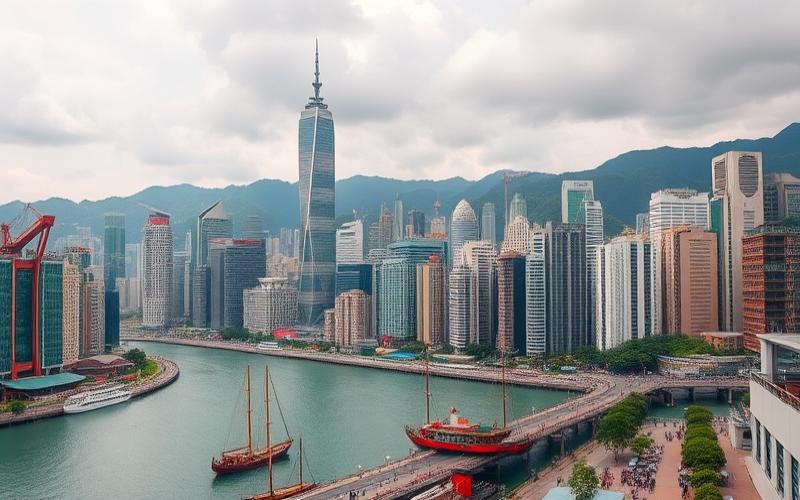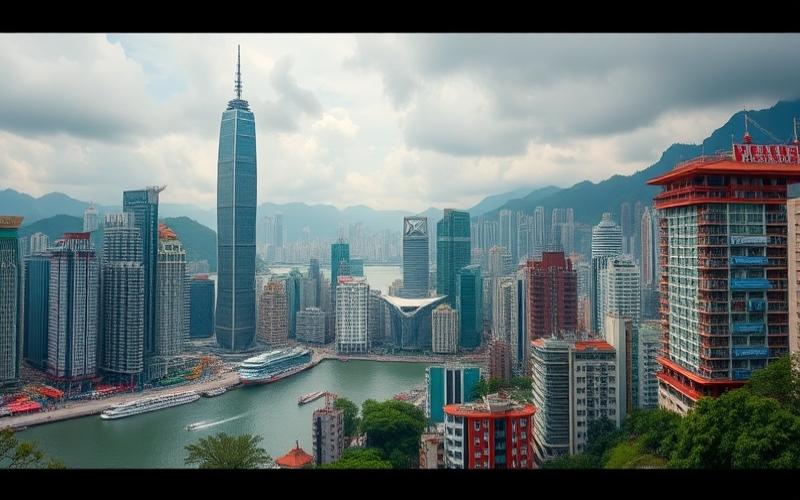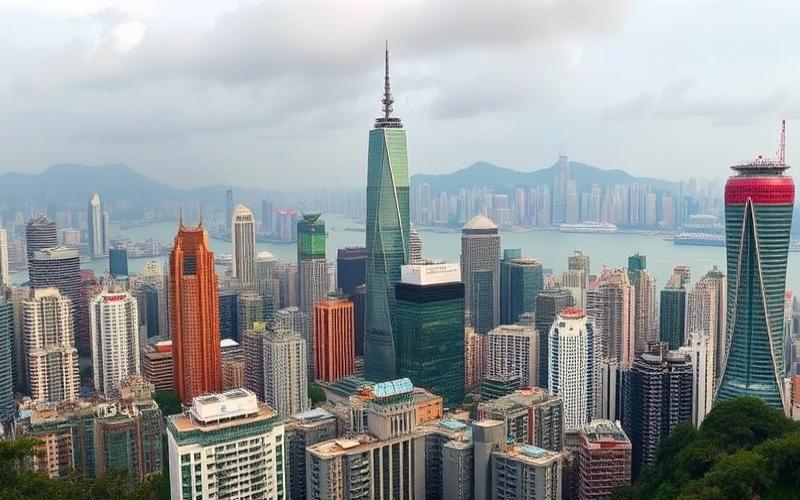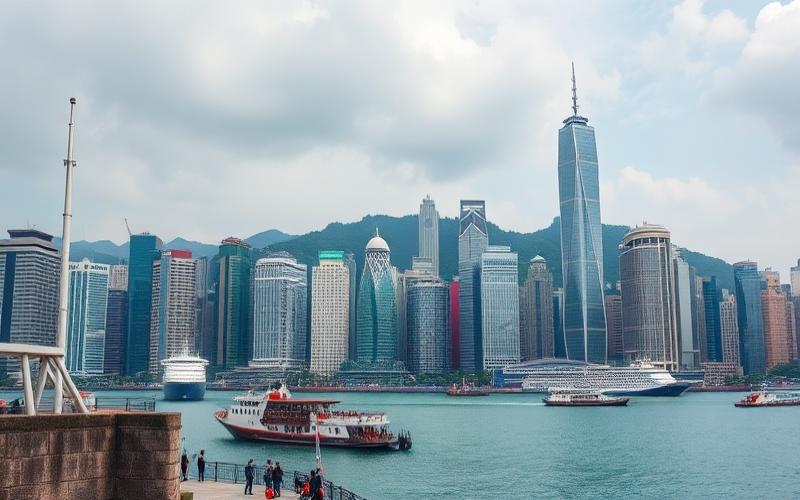
 Published on and written by Cyril Jarnias
Published on and written by Cyril Jarnias
In one of the world’s most densely populated cities, Hong Kong, where real estate pressure reaches unprecedented levels, “micro-apartments” are emerging as an ingenious solution for budget-conscious residents. These compact dwellings, often measuring less than 20 square meters, offer an affordable alternative to traditional homes while requiring significant compromises on living space.
At the heart of this trend lies a population of students, young professionals, and individuals seeking independence, for whom these reduced spaces are both a necessity and an opportunity to adopt a minimalist and pragmatic lifestyle.
The major challenge lies in reconciling the desire for contemporary comfort with the constraints of a tiny space, thereby questioning the sustainability of these long-term solutions for Hong Kong’s real estate landscape.
Microliving in Hong Kong: An Expanding Trend
The concept of microliving in Hong Kong originates from the city’s unique history, marked by extreme urban density and continuously rising property prices. Starting in the 1950s, a massive influx of Chinese migrants saturated the existing housing stock, first leading to the proliferation of slums and then to the creation of tiny residential units as a quick response to housing crises. This phenomenon intensified over the decades with economic and demographic growth, transforming the local real estate market.
Key Factors Driving This Trend
- One of the highest urban densities in the world
- Among the most expensive square meter prices globally
- Scarcity of available land
- Rapid urbanization and migration pressures
- Local regulations eased since 2011 to facilitate the supply of small housing units
These conditions have led to the multiplication of micro-apartments (microflats), whose numbers exploded in the 2010s.
| Key Factors | Explanations |
|---|---|
| Population Density | Highly populated city on a limited territory |
| Rising Prices | Unaffordable real estate for the majority |
| Regulatory Responses | Eased regulations to promote compact construction |
Typical Characteristics of Micro-Apartments
- Area typically between 15 and 28 m² (often less than 200 square feet)
- Absence or scarcity of fixed interior partitions
- Kitchen placed very close to or directly against the bed
- Integrated or shared bathroom depending on the case
- Modular furniture: foldaway beds, built-in high storage, foldable tables
Tips for Optimizing Space
- Systematic use of multifunctional furniture (sofa bed with drawers)
- Floor-to-ceiling cabinets
- Sliding doors instead of traditional swing doors
This format primarily targets individuals or young couples with limited budgets but who wish to remain close to vibrant urban centers.
Social and Economic Repercussions
Positive Effects
- Easier access to independent housing despite low purchasing power
- Opportunity for some essential workers and young professionals to stay in the city
- Temporary boost to the real estate sector through a segment attractive to investors
Negative Effects
- Conditions sometimes equated with residential precarity (“cage homes”)
- Health issues related to the lack of minimum living space
- Increased social isolation among some residents
- Criticism regarding overall architectural quality and psychological well-being
Responses to Criticism
- Real estate developers are now focusing on innovation in interior design, offering more all-in-one design solutions.
- The local government has adapted its regulations (e.g., revised minimum standards) either to encourage this residential type as a transitional solution or—under pressure from associations—to limit certain observed abuses.
- Repeated calls also aim for an ambitious revival of traditional social housing so that microliving does not become a structural inevitability but remains a temporary choice.
Good to Know:
Microliving in Hong Kong, a trend accelerating with soaring property prices and increasing urban density, has its roots in the need for affordable housing for a dense population. These micro-apartments, often less than 20 square meters, fully exploit every square centimeter through modular furniture and ingenious space optimization solutions, incorporating foldaway beds and high storage. While this option attracts young professionals and budget-conscious individuals seeking an affordable home, it also raises concerns about quality of life, privacy, and occupants’ mental health. Developers are responding by constructing modern, well-equipped structures, while the local government seeks to regulate this phenomenon by ensuring minimum quality standards. Initiatives are emerging to create sustainable communities within these reduced spaces, offering potential for social and economic innovation despite persistent criticism.
Advantages of Micro-Apartments for Investors in Hong Kong
| Criterion | Micro-Apartment | Traditional Apartment |
|---|---|---|
| Acquisition Cost | Low | High |
| Rental Demand | Very Strong | Moderate to Strong |
| Management and Maintenance | Simplified, Reduced Costs | More Complex, Higher Costs |
| Market Liquidity | High (Quick Resale) | Variable |
| Urban Space Optimization | Maximum | Less Efficient |
High Profitability Due to Strong Demand
The Hong Kong market experiences very sustained demand for affordable housing, particularly among young professionals and students.
This rental pressure ensures high occupancy rates and thus potentially higher rental yields compared to larger units.
Lower Initial Costs
Purchasing a micro-apartment requires significantly less starting capital than needed for a conventional-sized unit.
Additional costs (maintenance, monthly fees) are also reduced due to the small size of the dwelling.
Simplified Management
Daily management (maintenance, leasing) is simpler: less space implies fewer technical interventions and easier tenant turnover.
Smaller units are better suited for short-term or furnished rentals.
Liquidity in the Hong Kong Real Estate Market
Micro-apartments are among the most liquid assets: they are bought and sold quickly because they target a broad urban clientele seeking a first purchase or an affordable pied-à-terre.
Optimization of Urban Spaces
These dwellings promote the rational use of land in a densely populated city like Hong Kong.
Response to Minimalist Trends
Investing in this type of property follows the growing trend towards a minimalist lifestyle, favored by younger generations who prefer compactness, practicality, and central location over volume.
Potential Tax or Regulatory Benefits
Some local policies may encourage this type of investment through:
- Reduced transfer duties for small units,
- Favorable taxation on furnished rentals,
- Occasional incentives aimed at increasing the supply of affordable housing.
Summary List of Main Advantages
- Higher profitability due to high occupancy rates
- Accessible investment with controlled initial costs
- Ease of daily operational management
- Strong liquidity during purchase/resale in the local market
- Spatial optimization addressing contemporary urban challenges
- Alignment with societal shift towards minimalism
- Possible incentivizing tax measures
Thus, micro-apartments represent an attractive investment combining financial accessibility, optimized returns, and portfolio flexibility.
Good to Know:
Micro-apartments in Hong Kong represent an attractive opportunity for investors due to the high profitability they offer, driven by strong demand for affordable housing and a shortage of space in the city. Their reduced size means lower entry costs and simplified management compared to larger properties, while ensuring increased liquidity in the local real estate market, where transactions often occur quickly. By aligning their investments with the growing trend of urban minimalism, investors participate in optimizing urban spaces amid densification, while potentially benefiting from tax advantages or favorable regulations specifically designed to encourage this type of investment in Hong Kong.
Yield of Small Spaces: A 2025 Perspective
Space Optimization in Hong Kong Micro-Apartments by 2025
Micro-apartments in Hong Kong maximize their yield through architectural and technological innovations, as well as interior design strategies focused on multifunctionality and optimizing every square meter.
Expected Architectural and Technological Innovations
- Increased use of movable walls and sliding partitions to reconfigure space according to daily needs.
- Integration of smart home technologies, allowing control of lighting, temperature, and furniture via mobile applications.
- Development of ventilation and acoustic insulation solutions adapted to small spaces to improve comfort and privacy.
- Modular unit design allowing rapid customization and the possibility to expand or reduce living space based on evolving needs.
Examples of Interior Design Strategies
- Versatile Furniture: Foldaway beds, convertible sofas, extendable tables, concealable integrated desks.
- Integrated Storage Systems: Drawers under stairs, full-height wall storage, built-in closets, vertical solutions maximizing ceiling space utilization.
- Use of Mirrors and Glass Surfaces to visually enlarge the space and increase natural light.
| Strategy | Concrete Example |
|---|---|
| Foldaway Furniture | Fold-down bed integrated into a bookshelf |
| Custom Storage | Drawers under the floor or steps |
| Movable Partitions | Sliding panels creating office/living space |
| Smart Home Technology | Adaptive lighting based on zone occupancy |
Demographic and Economic Trends
- Increase in single-person households, with nearly 20% of households composed of one person in 2023, a growing trend driven by young professionals and international students.
- Pressure on financial affordability continues to steer demand towards compact housing, as rents rise and some operators withdraw from the subdivided unit market.
- Investor interest remains strong, with rental yields supported by demand from newcomers, particularly talent visa holders and university students.
Advantages and Constraints of Micro-Apartments
| For Occupants | For Real Estate Developers |
|---|---|
| More affordable rent (compared to large apartments) | Optimized yield per square meter |
| Easy maintenance, centralized urban living | Strong demand in certain demographic segments |
| Increased customization through design | Regulatory complexity and legislative changes |
| Limited comfort, lack of privacy | Risk of vacancy if demand decreases |
| Risk of overcrowding and isolation | Necessary investments in innovative solutions |
Integration into a Sustainable Development Model
- Urban densification limiting urban sprawl and consumption of natural land.
- Reduction of per capita carbon footprint through shared resources (heating, air conditioning, common services).
- Promotion of minimalist lifestyles, limiting material and energy overconsumption.
- Challenges regarding well-being, requiring consideration of quality of life and access to collective spaces.
Key Takeaway:
Hong Kong’s micro-apartments in 2025 rely on design and technology innovation to meet sustained demand, while seeking to integrate principles of sustainable urban development despite social and economic constraints.
Good to Know:
Micro-apartments in Hong Kong, by maximizing spatial yield for 2025, could benefit from architectural innovations like modular structures and integrated smart home technologies. Versatile furniture, such as foldaway beds and extendable tables, along with integrated and clever storage systems, would optimize every square meter. Demand for these dwellings is sustained by demographic growth and economic pressure, thus influencing the real estate market in favor of dense yet functional urbanization. However, occupants must balance comfort and limited space, while developers face construction and regulatory challenges. Despite these constraints, these miniature habitats can significantly contribute to sustainable development by reducing the ecological footprint of buildings and paving the way for more efficient use of urban resources.
Challenges and Opportunities of Studios in Hong Kong
Studios and micro-apartments in Hong Kong are the result of major economic, legislative, and architectural challenges, but they also offer opportunities through design innovation and green technologies.
Economic and Land Constraints
- High Land Cost: Hong Kong has one of the highest property prices in the world, making homeownership difficult for a large portion of the population.
- Limited Space: The restricted territory and urban density force the optimization of every square meter, pushing developers to favor micro-dwellings.
- Impact on the Market: Studios become an unavoidable solution for young professionals and low-income families but raise concerns about quality of life and long-term accessibility.
| Economic Factor | Main Consequence |
|---|---|
| High Land Prices | Reduction of livable surfaces |
| Urban Density | Vertical development, micro-dwellings |
| Social Inequalities | Difficult access for modest households |
Legislative Issues and Public Policies
- Construction Standards: The government imposes strict regulations on safety and sanitation, but land pressure sometimes leads to compromises on minimum housing sizes.
- Urban Development Policies: Incentives exist to densify buildings and encourage the construction of compact housing, while maintaining sustainability and social mixity objectives.
- Rent Control: Although some measures exist, they remain limited in the face of real estate speculation.
Architectural Challenges and Innovations
- Space Optimization: Architects compete in creativity to integrate storage, modular furniture, and multifunctional spaces into areas often under 20 m².
- Green Technologies: Integration of energy-saving solutions, smart lighting, and sustainable materials aims to reduce the ecological footprint of micro-apartments.
- Innovative Interior Design: Use of removable partitions, mezzanines, and foldaway furniture maximizes habitability without sacrificing comfort.
| Architectural Innovation | Benefit for the User |
|---|---|
| Multifunctional Furniture | Space saving, adaptation to needs |
| Smart Home Solutions | Comfort and optimized energy management |
| Eco-friendly Materials | Reduction of environmental footprint |
Cultural and Social Impacts
- Young Professionals: Studios allow quicker access to urban life and employment, at the cost of reduced personal space and sometimes restricted social life.
- Low-Income Families: Micro-dwellings often constitute the only affordable option, with consequences on health, well-being, and family cohesion.
- Evolution of Lifestyles: The “nano-apartment” model shapes new behaviors centered on mobility, minimalism, and flexibility.
Opportunities for the Real Estate Market
- Diversification of Supply: Micro-apartments meet a growing demand for affordable housing in city centers.
- Dynamic Rental Market: High professional mobility fuels the development of flexible and short-term rental solutions.
- Innovation Potential: The constraint context stimulates the search for new residential models, exportable to other megacities facing similar challenges.
Visual Summary of Challenges and Opportunities
| Main Challenge | Associated Opportunity |
|---|---|
| Limited Space | Innovation in design and furniture |
| High Land Prices | Compact and affordable housing solutions |
| Legal Constraints | Development of architectural standards |
| Social Pressure | New forms of cohabitation and sharing |
Good to Know:
Studios in Hong Kong, essential for housing its residents, face challenges such as prohibitive land costs and limited space, leading to high population density. The government has implemented regulations to promote the development of affordable micro-apartments, but these efforts are often hindered by slow administrative processes. Thus, innovation in interior design, such as modular furniture, becomes crucial for optimizing space. Green technologies, like energy-saving systems, also offer opportunities to reduce long-term costs. These dwellings have a notable social impact, notably by providing acceptable solutions for young professionals and low-income families, while influencing the real estate market through growing demand, which could transform urban landscapes and increase the region’s economic competitiveness in the long term.
Disclaimer: The information provided on this website is for informational purposes only and does not constitute financial, legal, or professional advice. We encourage you to consult qualified experts before making any investment, real estate, or expatriation decisions. Although we strive to maintain up-to-date and accurate information, we do not guarantee the completeness, accuracy, or timeliness of the proposed content. As investment and expatriation involve risks, we disclaim any liability for potential losses or damages arising from the use of this site. Your use of this site confirms your acceptance of these terms and your understanding of the associated risks.












































